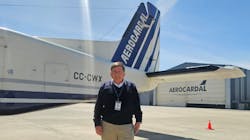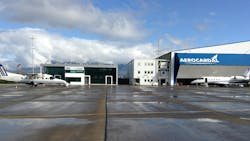How Latin America is Emerging as a Hub for Private Jet Maintenance
Key Highlights
- Latin American MROs are increasingly meeting FAA and EASA standards, reducing reliance on overseas maintenance and boosting regional confidence.
- Investments in training, tooling and traceability are enabling local facilities to support complex aircraft and meet international requirements.
- Partnerships with OEMs like Embraer are strengthening regional maintenance networks, improving logistics and reducing aircraft downtime.
When discussing private aviation in Latin America, most envision sleek jets whisking travelers away to Caribbean getaways, executives linking South America's capitals or tourists chartering planes to access points commercial airlines can't reach. None of this would be feasible, however, without something less glamorous and all too frequently overlooked: good aircraft maintenance.
Maintenance infrastructure is where the future of private aviation in the region—whether in terms of safety, availability or reputation—hangs in the balance. Where commercial networks are sparse and where geography has made aviation a necessity, being in a position to offer assurance that business aircraft are inspected, certified and maintained flight-ready is the foundation of trust in the industry as a whole.
In fact, beyond the concept of being “flight-ready,” operators and regulators increasingly emphasize airworthiness—a term that captures not only readiness to fly, but also strict compliance with regulatory and technical benchmarks.
What is the maintenance ecosystem in Latin America?
Latin American private jets operate under a different set of circumstances compared to those in North America or Europe. Operators have to navigate special demands posed by challenges like:
- Extended overwater flights
- High-altitude airports
- Volcanic landscapes
- Isolated strips with minimal support infrastructure
In contrast to scheduled airlines, which can draw on large fleets and highly developed MRO networks, private operators tend to be single-aircraft dependent and can find themselves in areas with limited or no local technical support.
One missed inspection or tardy spare part can leave an aircraft stranded far from home. This halts not only vacation travel but also vital missions, such as:
- Medical evacuations
- Mining activities
- Government flights
Here, reliability is not a luxury, it’s a necessity. The operators in the region insist on airplanes being available on demand, and the passengers insist on the same perfect experience they would receive anywhere else in the world. Delivering that requires local MROs to have international standards of airworthiness.
Traditionally, private operators in Latin America went overseas for heavy maintenance, often flying aircraft to Miami, Houston or Dallas. This practice perpetuated the view that world-class standards could not be achieved locally. That view is changing.
There have been some investments by local MROs in capabilities to meet FAA or EASA requirements. These shops are proving the region can equal the same standards as Europe or the US. It has not been an easy task, as international standards require heavy investment in areas like:
- Training
- Tooling
- Traceability systems
- English-language technical capability
But those investments are beginning to yield returns. Owners and operators increasingly feel comfortable basing aircraft in South America with the knowledge that high-level inspections, avionics upgrades and unscheduled repairs can be accomplished without leaving the region.
A case in point is Aerocardal in Santiago, Chile. From a one-time charter and medevac operator, the company has built its Maintenance Center into a full-fledged MRO. Certified by Chile’s DGAC and the US FAA as well as meeting EASA requirements, Aerocardal demonstrates that South America can provide facilities of international renown.
Beyond Embraer, the company has expanded the scope of services in the region by maintaining service-center certifications for aircraft like:
- Gulfstream
- Leonardo/Agusta Helicopters
- Pilatus
- Cirrus
Why is meeting global standards important?
The significance of international approvals in Latin America cannot be overstated. To achieve FAA or EASA acceptance means that local maintenance practices, documentation and quality controls meet the standards of the most demanding regulators.
Aircraft maintenance involves more than just a hangar and some tools. It requires considerations and preparation like:
- Systems for total traceability of parts
- Highly planned maintenance schedules
- Rigorous quality-control procedures
Just as important, globally compliant aircraft maintenance requires human capital. Technicians need to be trained to international standards, often traveling abroad for manufacturing training and keeping up with service bulletins and evolving inspection cycles.
Aerocardal, for instance, operates a mixed fleet that comprises:
- Gulfstream jets
- Pilatus turboprops
- Cirrus piston aircraft
- Aircraft Industries L 410 NG
Each has unique engineering requirements, and the option to have them serviced locally saves customers downtime and the cost of sending aircraft north for service. By adopting global procedures in local operations, top facilities across Latin America are learning that the region can support world-class operations.
This role extends beyond executive aviation. Aerocardal has also provided maintenance for the Chilean Air Force, performing work on its Gulfstream G4 fleet and, more recently, securing agreements to service the institution’s Cirrus fleet.
The company has also supported Carabineros de Chile (National Police) by maintaining their Agusta 139 helicopter. These collaborations highlight how Latin American MROs contribute to private aviation and to national capabilities in defense and public safety.
One of the strongest indications of change is how aircraft manufacturers are beginning to perceive Latin American maintenance providers. For years, OEMs were reluctant to issue authorizations outside North America or Europe, citing market size concerns or quality control issues. That also is changing.
In 2025, Embraer appointed Aerocardal as an Authorized Service Center for the Phenom 300 series in Chile—a benchmark that reflects increasing demand as well as confidence in regional expertise. This designation enables Aerocardal to provide line maintenance, unscheduled inspections and AOG support with the backing of the manufacturer itself.
The repercussions go beyond a single company. By placing factory-supported service in a Chilean facility, Embraer has made a statement to operators throughout the continent: Latin America can sustain complex maintenance networks.
Logistics are also getting better through Embraer’s Miami hub, with the company seeing benefits like:
- Faster transit of parts to Chile
- Minimized downtime
- Enhanced reliability for regional operators
Partnerships like these signal an industry-wide evolution. As manufacturers integrate local MROs into their global networks, operators benefit from reduced costs, faster service and the assurance that their aircraft are supported by trusted providers without leaving the continent.
How to overcome misconceptions about Latin American MROs
In spite of advances in the sector, Latin American MROs still face hurdles. There is a lingering perception that maintenance in Latin America is somehow less exacting than in the United States or Europe. That perception is fueled whenever an operator opts to ferry an aircraft overseas for work that could be performed locally.
Shifting this script demands repeated proof that local MROs perform on schedule, meet safety standards and communicate well with international clients. Places like Aerocardal have a part to play here, but so does the broader industry, as each success story contributes to regional credibility.
There are also global challenges shaping the MRO sector. A worldwide shortage of mechanics and technical specialists has created competition for skilled labor. To retain talent, companies must:
- Provide attractive jobs
- Keep mechanics motivated
- Ensure permanent training opportunities
At the same time, supply-chain pressures are intensifying. Spare parts are scarcer, prices are rising and freight costs are increasing. For MROs, success requires a coordinated process across client planning, production teams and logistics to minimize disruption.
The wider gain is systemic. The more operators decide to base aircraft in Latin America, the more robust the ecosystem becomes. As aircraft are stationed in the region for maintenance, demand increases for spare-parts logistics, training courses and specialist suppliers. In the long term, this generates a virtuous circle that reinforces the industry as a whole.
Chile offers a perfect example of why this debate matters. The country’s geography from the Atacama Desert to Patagonia makes aviation indispensable. Airplanes are used by mining, agricultural and tourism business leaders to span vast distances. Medical transport is often a matter of hours, not days. And trips to places like Easter Island are possible only due to aviation.
In all of these instances, confidence in local maintenance has a direct impact on trust in aviation. When operators are confident that their aircraft can be maintained locally, they are more inclined to:
- Retain assets within the region
- Hire local crews
- Establish long-term relationships with suppliers
That stability encourages additional investment in infrastructure, to the benefit of the entire ecosystem.
This is the larger narrative: maintenance is not merely a technical service but also a strategic facilitator of expansion in Latin American private aviation.
How to build trust as the industry develops
Ultimately, private aviation is built on trust. Passengers trust crews to deliver them safely, owners trust operators to keep aircraft in top condition and operators trust MROs to uphold standards without compromise.
For Latin America, reaffirming that trust is at the heart of the industry's future. As private aviation demand expands, so does the onus to make sure every aircraft in the region is backed up by maintenance services that are on par with worldwide standards.
Operators such as Aerocardal demonstrate that it can be done with assurances like:
- FAA and EASA acceptance
- Manufacturer support such as that of Embraer
- Service-center certifications from Gulfstream, Leonardo/Agusta, Pilatus and Cirrus
- Investment in process and people
South America demonstrates that the reliability of Miami, Dallas, or Zurich is not their prerogative alone. It is also in Santiago, São Paulo or Bogotá.
Maintenance may occur behind the doors of the hangar, out of sight of passengers. But it is the cornerstone upon which the reputation of private aviation is built. And in Latin America, that cornerstone is growing more solid each year.
About the Author

Felipe Fernández
Felipe Fernández is the Maintenance Director at Aerocardal

